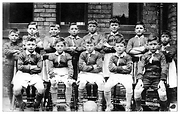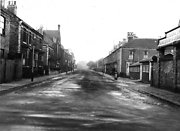 Hartlepool Sports & Leisure
Hartlepool Sports & Leisure
- Cinemas, Theatres & Dance Halls
- Musicians & Bands
- At the Seaside
- Parks & Gardens
- Caravans & Camping
- Sport
 Hartlepool Transport
Hartlepool Transport
- Airfields & Aircraft
- Railways
- Buses & Commercial Vehicles
- Cars & Motorbikes
- The Ferry
- Horse drawn vehicles
 A Potted History Of Hartlepool
A Potted History Of Hartlepool
- Unidentified images
- Sources of information
- Archaeology & Ancient History
- Local Government
- Printed Notices & Papers
- Aerial Photographs
- Events, Visitors & VIPs
 Hartlepool Trade & Industry
Hartlepool Trade & Industry
- Trade Fairs
- Local businesses
- Iron & Steel
- Shops & Shopping
- Fishing industry
- Farming & Rural Landscape
- Pubs, Clubs & Hotels
 Hartlepool Health & Education
Hartlepool Health & Education
- Schools & Colleges
- Hospitals & Workhouses
- Public Health & Utilities
- Ambulance Service
- Police Services
- Fire Services
 Hartlepool People
Hartlepool People
 Hartlepool Places
Hartlepool Places
 Hartlepool at War
Hartlepool at War
 Hartlepool Ships & Shipping
Hartlepool Ships & Shipping

Avenue Road School
Details about Avenue Road School
The school was fee paying and was on the corner of Avenue Road and Thornton Street in an area demolished in the 1960s to make way for Middleton Grange Shopping Centre. It opened in 1904 in a building formerly used as a Wesleyan School and appears to have closed in 1940.
See notes taken from school log book
Location
Related items :
 Avenue Road School
Avenue Road School
Notes from Log Book in Teesside Archives
The school opened in 1904 having been bought by West Hartlepool Education Authority from the Wesleyans . It had been the Wesleyan Higher Grade School and in 1904 it was in some way renovated.
In 1904, there were 345 on roll. It was a fee paying school and the log book of 1904 says:
Grants @ 22shillings a head = £379.10s
Cookery 88 @ 4 shillings= £7.12s
Reports by inspectors of 1915 call the school ' a fee paying council school'
Nov 28th 1916 school closed owing to zeppelin raid which affected several people
July 1923, 379 on roll-- 15 boys and 8 girls left for Elwick Road and 12 boys and 6 girls to seconary and high schools
Inspection of 1938 said 'premises not good, classrooms uneven, playground small, offices (toilets?)unpleasant, old fashioned type with no individual flush, no indoor sanitary provision for staff. Numbers are decreased and it would be an advantage if thet were somewhat further reduced so that there need only be one class in the most northerly room at present divided by partition providing two very small teaching areas'
Sep 8th 1939, an evacuation party took 103 children to Saltburn. The teachers taking them were Miss Coldray, Miss Lincoln and Miss Pinkney(later head of Rossmere Infants')
In Oct 1939 there were 82 boys, 63 girls and 70 infants
Jan 1940, the school was taken over by the military. Staff were deployed and children were transferred to the following schools;
Lister Street 145
Oxford Street 7
Lynnfield 28
Jesmond Road 1
Dyke House 1
More detail »
 Avenue Road School FC - 1933
Avenue Road School FC - 1933
 Created by Unknown
Donated by Roger Codner
Created by Unknown
Donated by Roger CodnerPart of the Rogner Codner collection
Dated 1933
A picture of the Boys at Avenue Road, corner of Thornton Street.
Can any one advise the names of the team!
More detail » Avenue Road looking north from Villiers Street
Avenue Road looking north from Villiers Street
 Created by West Hartlepool Council
Part of the Library collection
Created by West Hartlepool Council
Part of the Library collectionDated 1956
Victory Square can be seen in the right distance where the trees are.
Thornton Street runs right to left beyond the Coop Dairy on the right.
Just beyond Thornton Street, the higher building on the left had originally been Avenue Road School and then the Technical School Annexe.
The photo was from a photographic record of the Central Area of West Hartlepool prepared in 1955/6 at the request of the Town Planning and Redevelopment Committee 'in the hope that it will be of interest to future generations of West Hartlepool'
The record focuses on areas which were within the next ten years to be completely redeveloped following The Max Lock Plan. It was compiled by WL Taylor and photographs developed by Thomas Clarkson Chemist of Tower Street.
More detail » Sir Edward Mellanby
Sir Edward Mellanby
Edward Mellanby was born in West Hartlepool the youngest of six children whose father, John Mellanby, was a manager of a shipyard for the Furness and Withy Shipbuilding Company. Edward was educated first Avenue Road School in West Hartlepool and then at Barnard Castle School where he showed both great athletic and scholastic prowess. In 1902 he left for Cambridge where he studied physiology. Between 1905 and 1907 he became a research student of Emmanuel College and published his first paper in 1908. Edward then went to St Thomas’s Hospital in London to do his medical training and was a demonstrator in physiology from 1909 to 1911. In 1913 he took on the role of lecturer and later became Professor of Physiology at King’s College for Women. In 1920 he became the first occupant of the Chair of Pharmacology at the University of Sheffield while, at the same time, he was appointed Honorary Physician at the Sheffield Royal Infirmary. In 1933 Edward was made Secretary to the Committee of Privy Council for Medical Research and Secretary of the Medical Research Council for whom he worked until his retirement in 1949.
During the 16 years he worked for the Medical Research Council he also carried on his own personal research at his laboratory in Sheffield where he studied the science of nutrition. This included nutrition deficiencies and the effects of various toxins in foods and the benefit of vitamins, mainly on the once common disorder of rickets. His findings into experiments with dogs who were given a restricted diet and kept indoors developed rickets but were then fed cod liver oil and recovered. These findings were published in the medical journal Lancet in 1919 and led to the discovery that rickets was caused by a lack of sunlight which resulted in a deficiency of vitamin D. He also studied the effect of alcohol on the brain and his findings became known as the Mellanby Effect. His work in this and other areas saw him become one of the founders of the Nutrition Society.
When Edward died suddenly of heart failure in 1955 there was great accolade for his achievements during his lifetime. He was knighted in 1937 and gained many letters after his name, GBE, KCB, MD, FRCP and FRS. He also could boast numerous publications which contributed greatly to the understanding of the importance of nutrition.
Donated by Richard Mellanby BSc BVMS PhD DSAM DipECVIM-CA MRCVS
More detail » Successful Scholars of the Wesleyan School 1871-1913
Successful Scholars of the Wesleyan School 1871-1913
Avenue Road Wesleyan School (later Avenue Road School) appears to have been one of some repute as the following are listed in WR Owen's 1913 'Remeniscences of Education in West Hartlepool' and this is not the case in other schools.
'Many Scholars of this school have done exceedingly well in after life. The following are a few examples;
Rev. Salton (American Methodist Church)
Joseph Mace (Wesleyan Minister Edinburgh)
Charles Johnson (Wesleyan Missionary West Africa)
Prof Alexander Mellanby Dsc. (Secretary of engineering Glasgow University)
Prof. John Mellanby MD Bsc etc.(Medical Research Singapore)
Prof. Edward Mellanby MD BSc (Medical Research Cancer ,London) Long after the 1913 book was written, he was the man who discovered Vitamin D during his research into rickets in 1919 and he was knighted in 1937
Frank Lund, H. Pearson. J. Pearson, CH Ford all shipowners
F W Lewis (director and London manager of Furness, Withy and Co)
R Coleman (NER Estate agent and councillor)
J Groves (Chief Government official in China)
J Gordon (Judge in Calcutta)
Arnold Branson (Gas and Water engineer and manager)
Robert and TA Jobson (shipbuilders)
G Wheelwright (Contractor Australia)
J Coombes (leather manufacturer Lincoln)
Frankland (millionaire meat packer)
Thos Liddle JP (Board of Trade)
James Boanson (master painter)
Fenwick (leading tenor St Paul;s Cathedral)
F Gordon (professor and tenor London)
Mr Dunbavand the head teacher was headmaster in 1871 and at the time of the 1913 book and obviously enjoyed a lot of success. The school was fee paying and possibly favoured by the more affluent members of the town.
More detail »



